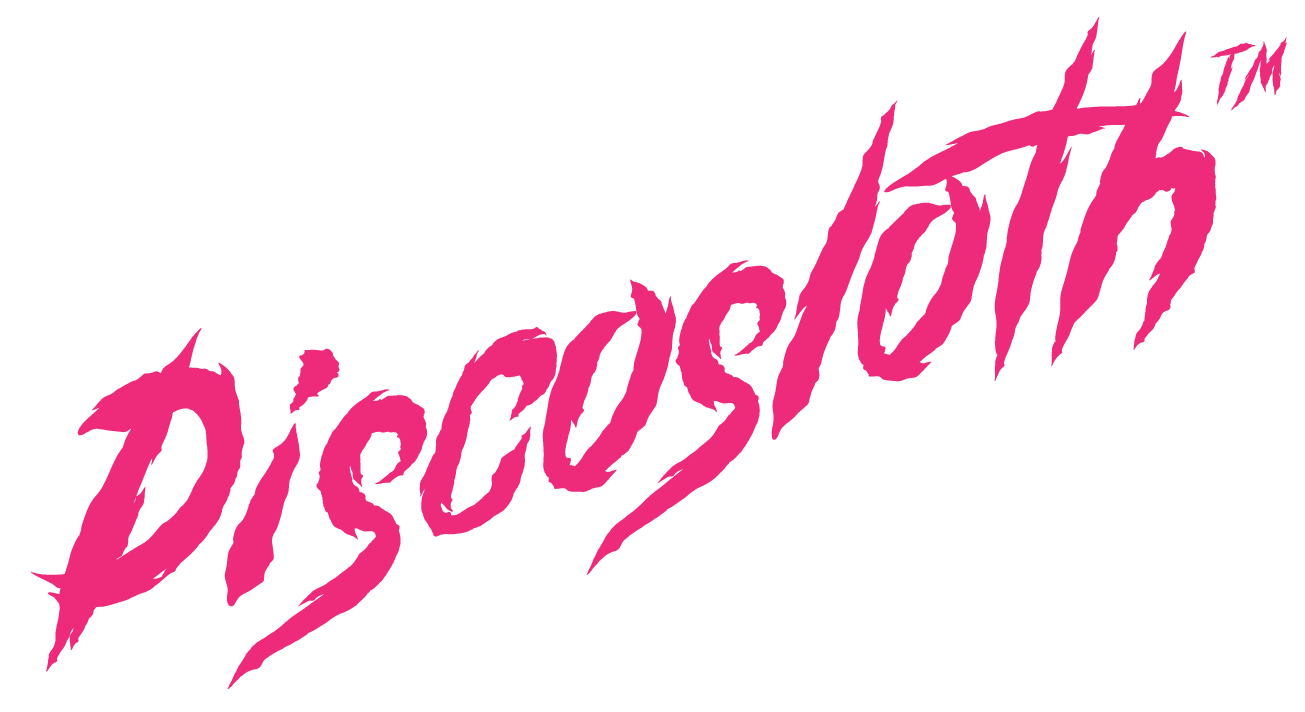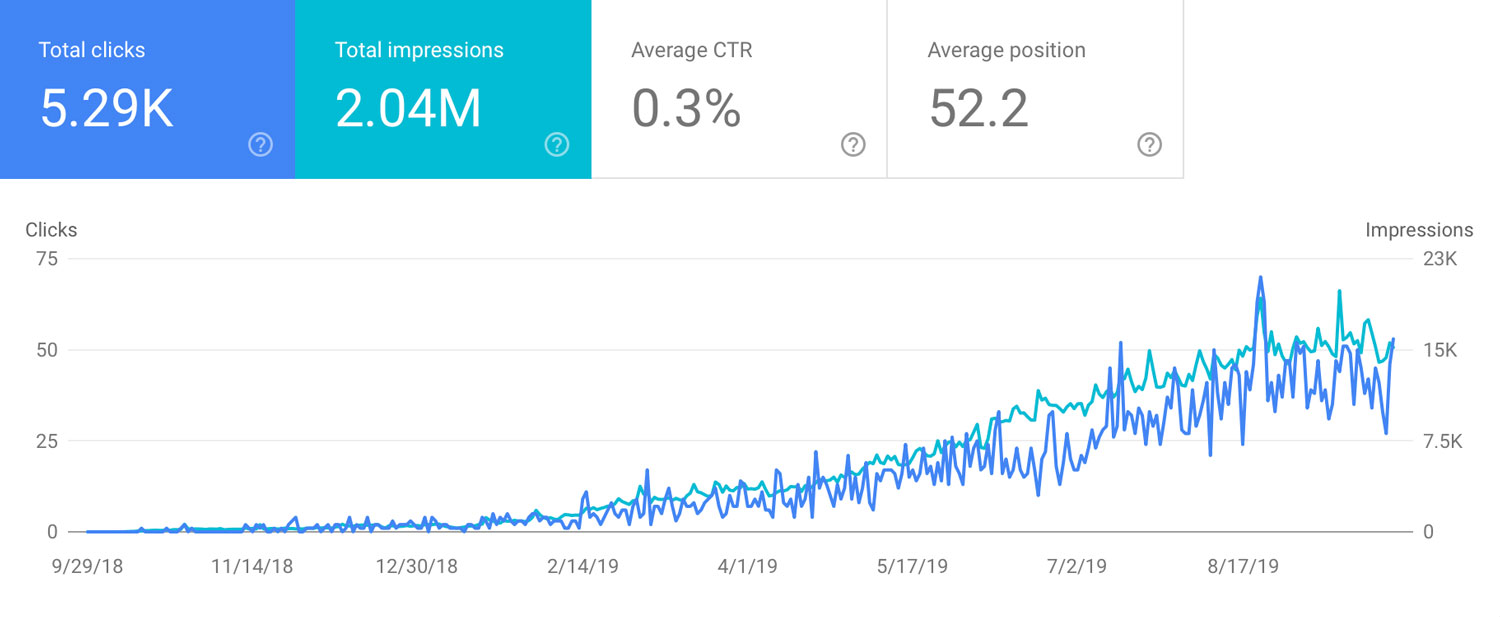This case study was originally published in 3 parts, with incremental updates coming along in the course of a year.
Now that our site is chugging along nicely, I thought I’d condense these into one long article so that you can see the full progression of our project.
In January of 2021, we hit a total of 100,000 unique visitors to our site – without ever paying for a single link, or doing much outreach at all. We are now averaging around 5000-7000 visitors a month, and that number is slowly increasing.
Part 1: February 20th, 2019
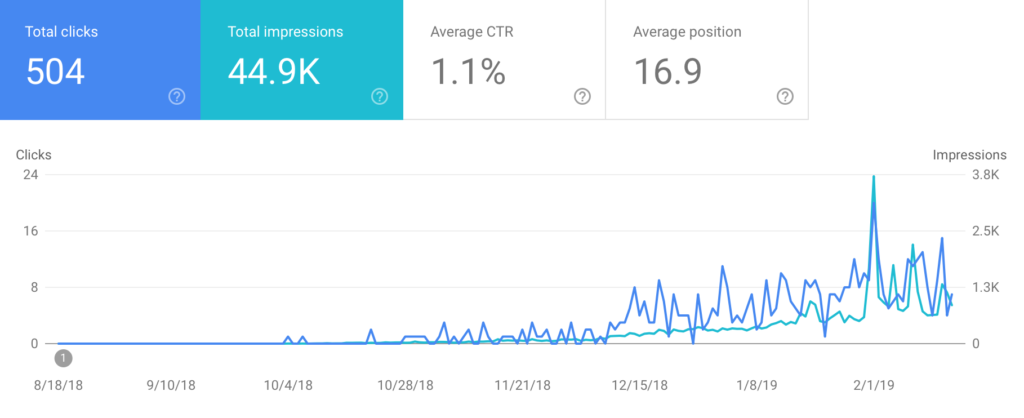
When I first started in SEO, I kept reading case studies on how to start a website from scratch.
They went through all the typical steps: build a site, build links, use social networking to promote it, use advertising, guest post, etc.
Those are all excellent tips: for those of us with a large social presence, a large ad budget, and plenty of experience under our belts.
But when I first started, I didn’t have any of that. None of my followers were interested in the sites I was building, I didn’t have the money to advertise, and I didn’t have the time or ability to build hundreds of quality backlinks.
In this case study, I’m going to show you some real numbers and real tactics we used to build a site from scratch and start getting some traffic: without building a single “followed” backlink.
I’m doing this case study in two parts: the first part will be published right now when the site is only 5 months old. The second part will be published later this year.
I’ll have to apologize for the first part of the case study. It is going to be very obtuse. I don’t want to reveal the domain or too many details just yet, because we still have several months of experimenting and work to do, and we plan to continue work in as “controlled” an environment as possible, without outside influences.
Right now we’re getting over 1,250 unique visitors a month, with around 400 of those coming from organic traffic.
A little bit about the site itself
In October, my friend Stu and I decided to launch a new website. We’re both massive nerds, and this particular site is dedicated to a specific subset of nerdy 80s nostalgia that we are in love with.
Vague enough for you? Sorry – that’s about as detailed as I can get right now.
The site is not in a highly commercial niche, which is probably a factor in our quick growth. It does have some competition in around a dozen established blogs and sites that have been around for 10 or 15 years. At first I wasn’t even sure the volume or interest was even there, but I was proven wrong.
Originally, I wasn’t even thinking about using this site in a case study. I had no idea it was going to be successful. Within a month, however, I knew we were on to something, so I started keeping track of our activities.
Phase 1 – Setting up the site
I registered the domain and set up a simple WordPress installation. I spent a few hours modifying a custom theme – I wanted a highly visual, but still clean and simple design that looks a lot like a wiki. WordPress is not an ideal pick, because it’s a very slow and bloated CMS, but since both Stu and I were going to be working on content, I decided we needed to use something fairly common.
The site is hosted on a shared Dreamhost package, on a typical Apache server. Nothing fancy at all. It costs $12/mo.
The site speed is not terribly impressive, but that’s mostly because of two factors:
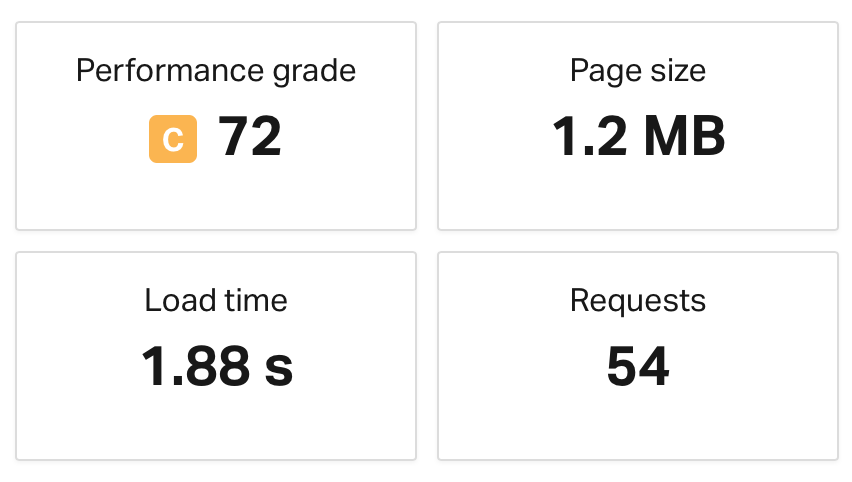

First, the site is media-intensive. We have a lot of large images (we get over 30% of our traffic from Google Images search – more on that in a minute).
Second, the site is a WordPress site, and WordPress sucks. Even though we are compressing files, have paid lots of attention to optimizing images, and following all the standard best practices for site speed, I have yet to see a WP site that doesn’t suffer from bloat. It’s a real problem and something I hope will someday be fixed.
We are using the standard pack of plugins to track our SEO progress on the site: Google Analytics and Yoast.
Phase 2 – Creating content for the site
This is the crux of our strategy. And this is where it was truly a little crazy.
We created a lot of content for the site: 78 individual posts and 5 pages, to be exact. All of this was totally original, exhaustively researched, and written by us.
The content was also in a niche that has almost no existing information out there – some of the topics we wrote about aren’t even on Wikipedia. It’s truly unexplored territory. Only a handful of blogs, as mentioned above, cover some of these topics.
Each of the posts averaged around 500 words, although some were closer to 1000 words. We created around 10-15 original pictures for each post, keeping them under 300kb each and over 1200px on the shortest side.
Now, an important aside is that we get a huge amount of traffic from Google Images. I’m confident this is because we’ve spent so much time optimizing these images, keeping alt tags, captions, and metadata within the images in mind. This is the traffic coming from Google Images alone:
The reality is that this is a whole lot of content, and for most beginning site creator this strategy only makes sense if you are creating the content yourself. I did the math – if someone came to us at Discosloth and requested a quote for the content marketing done on this project, we would have billed $27,300.
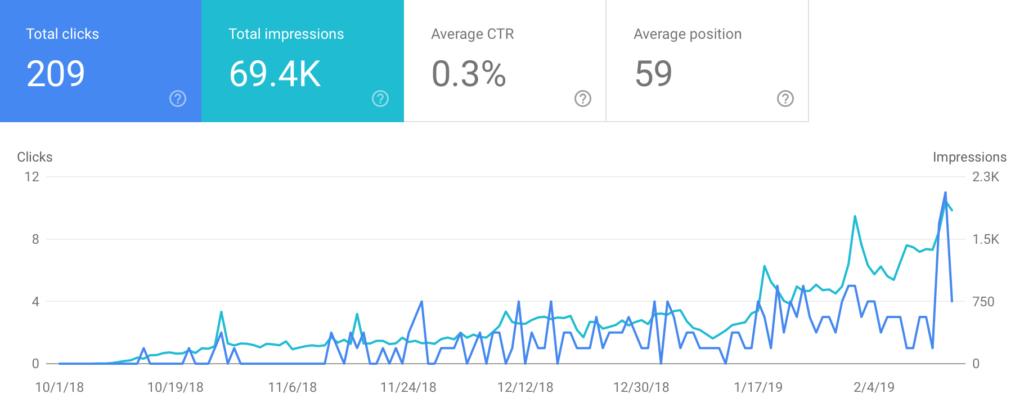
Obviously that’s out of the question for a brand new, unproven site. But you just can’t be cheap on content these days. It’s got to be original, well-written, researched, and optimized. So, you’ll probably have to do that yourself unless you’ve got a content marketer on staff with some free time.
Over a five-month period, we published 78 posts – so just about one post every other day. We did not worry about timing – it just doesn’t matter when you’re creating this much content.
Phase 3 – Amplifying the content on the site
We created this site from scratch. There was no existing domain, no personal brand equity attached, no existing social handles.
I hooked up Analytics and Google Search Console. After the site was up, Stu went through and created handles at most major social platforms (Pinterest, Tumblr, Twitter, and Google+ R.I.P.) and linked them to the site. We also posted on niche Reddit subs whenever we had a piece we thought resonated.
Currently, our social following has climbed to 197 followers on Twitter, and 10 followers on Pinterest.
We mentioned that we didn’t build links. That’s true – but that doesn’t mean we didn’t accumulate them. For a variety of reasons, other folks started linking to the site. Some seem to be automated scrapers, but we’re fine with that – it doesn’t hurt us. The vast majority seem to be real, valid links – over 150 of them to be exact.
As the months went on, we found which sorts of content gained the most traction via organic searches, and started focusing on those.
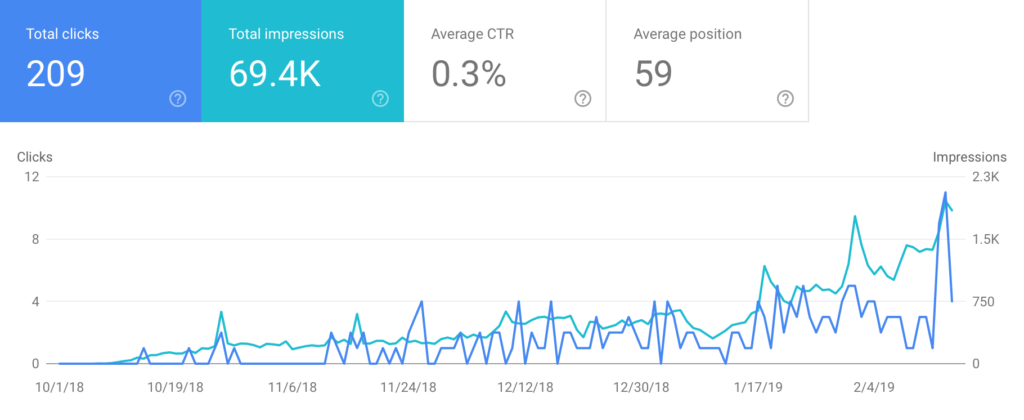
New sites aren’t going to rank for high-volume, high-interest keywords. They just simply aren’t. So we focused on super niche topics with almost no volume. We knew we couldn’t create one piece that ranks on the first page for 10,000 searches a month – so we created 50 pieces that rank on the first page for 200 searches a month.
Phase 4 – Looking at the performance so far
Here’s where it gets fun – breaking down the traffic we received in the first 5 months.
It’s worth noting that Google Analytics does not always do a great job of reporting channels, and that’s why you see so many “direct” visits. That’s because Safari, one of our highest-volume, highest-performing browsers, has recently introduced some privacy features which block a lot of personally identifiable information from Analytics. From doing some dives into the data and watching day-to-day, I can tell that a large percentage of those “direct” visits are actually correlated with posts on Reddit, and another large percentage is correlated to spikes in organic traffic. Absent a better data set, I’d say that most of the “direct” visits need to be assigned to either organic or referral categories.
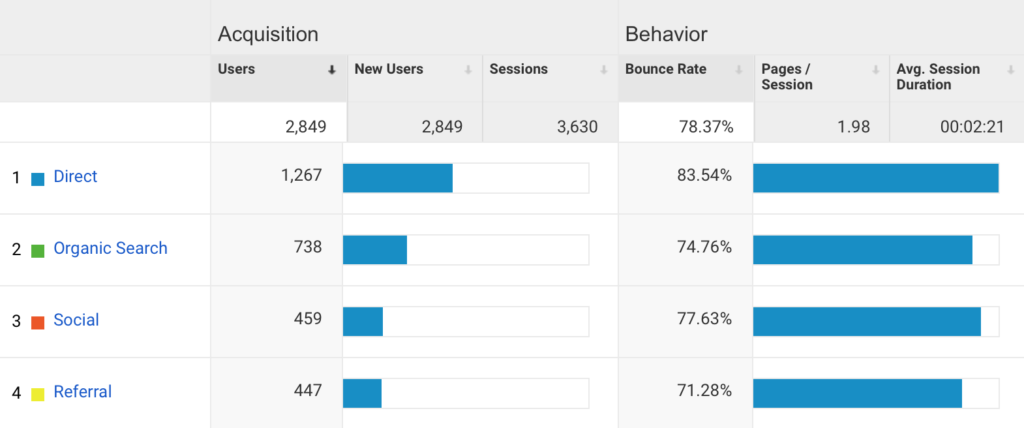
Organic traffic is our Shangri-La, because it’s so hard to get and so valuable to keep. We were very pleased with such a wide range of search engines. Obviously Google is the largest with 635 visits, but that’s followed by:
- Bing (58)
- Yahoo (27)
- DuckDuckGo (14)
- Yandex (16)
- Seznam (4)
- AOL, Ask, Baidu, and Ecosia (1 each)
Traffic from social platforms:
- Reddit (256)
- Facebook (172)
- Tumblr (47)
- Pinterest (18)
- Twitter (7)
Referrals are a little trickier for me to report right now, without majorly revealing the domain of our site, but traffic referred from non-social-media sites is 378 in total.
We also added a newsletter signup on the site a few weeks ago, and have gotten 15 signups so far.
The engagement across the board looks pretty awesome. The average time on page from all channels is well over two minutes. Some of that is probably skewed by some outliers we’ve seen – there seems to be quite a few no-life nerds who have spent hours on the site, reading 15-20 pages. I’m not talking about myself. No, not at all.
Demographics are equally awesome, since we have the majority coming from tech-forward countries (the United States leads the pack at 69%, followed by Canada at 5%, the UK at 4%, Germany at 2.7%, Australia at 1.9%, and Ukraine at 1.7%).
The majority of users are males aged 25-44, which fits in with our assumption that only the nerdiest of neckbeards actually want to read about the sort of geeky crap we’re writing about.
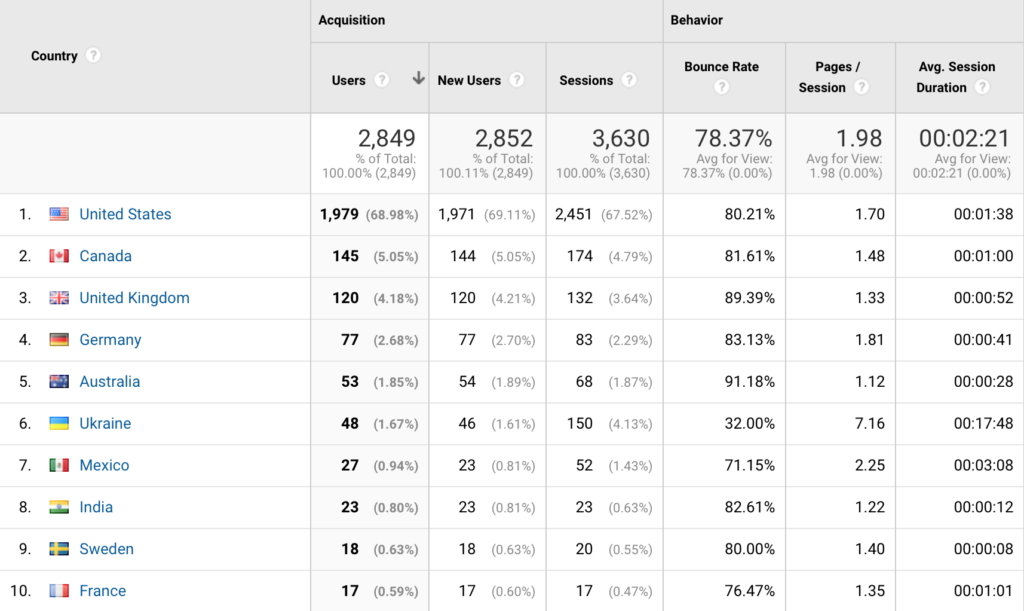
Phase 5 – Deciding what’s next
We’re going to keep on keeping on. We will maintain the same content plan (it gets exhausting publishing 3-4 articles a week, but it’s all in the name of science).
We haven’t actively built links or pushed for traffic from external sites, but I’m considering reaching out to others in the niche and doing some cross-promotion. This could increase our ongoing referral traffic quite a bit.
If we continue at the same pace, when our one-year anniversary rolls around on October 1st, we should be at around 3,500 visitors a month. At that point we’ll probably have around 175 unique pieces of content on the site. I’m hoping that we see a little exponential growth, especially if we end up creating a few links or getting some extra attention on the site.
Give me a few more months, and I will publish part 2 of this case study, and reveal a little bit more (including the domain, screenshots, specific search queries, and all the stuff that is really useful!) But until then, I’m going to enjoy building this site up in anonymous peace.
P.S. A commentor asked what our commercial purpose is for the site. Answer: it doesn’t have one yet. There is a reason for this: starting a site from scratch with commercial intent is difficult. Users want enjoyment, not being sold something, and I honestly don’t think we would have seen the same rate of success if our early users arrived at the site and were onslaught by sales pitches.
Part 2: May 7th, 2019
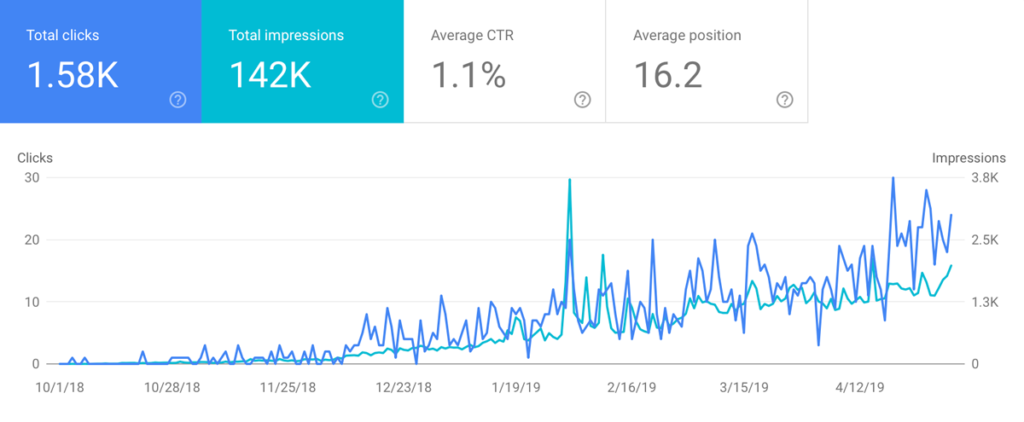
This February, I wrote a short case study called How to start a site from scratch and get traffic without building any backlinks, part 1. That post got quite a bit of attention, and now I want to follow it up with part… wait for it… 2.
In the last section I refrained from linking to the domain or revealing too much about the site, since I wanted to keep it somewhat of a virgin testing ground (a couple clever SEO folks found it, anyway). Now, three months later, it’s time to reveal everything.
At this point, the website has been live for eight months. The growth since the previous post has been fairly satisfactory, to my pessimistic self at least. And get this: we still haven’t done a linkbuilding campaign.
Now, a bit of a caveat here. We haven’t built any followed links. But, especially in the last few months, we’ve done a huge social media push which has resulted in a lot of referral and social traffic from all over the place, and like I referenced in the first post, it’s also picked up some links naturally along the way.
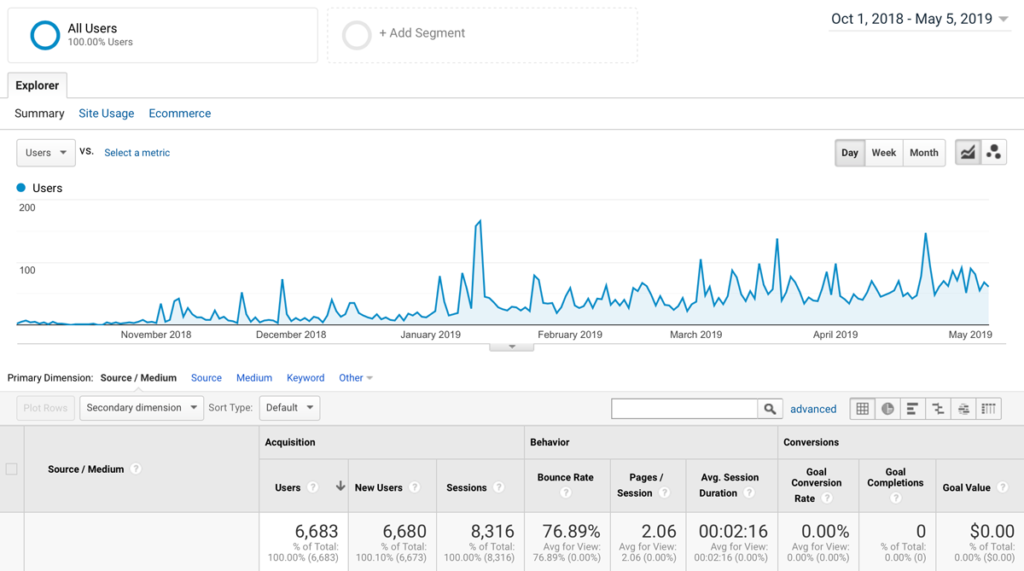
Before I reveal the site, some stats. We’re at around 2,500 unique visitors a month at the moment. Around 50-60% come from search engines. The engagement is amazing: an average time on page of 2 minutes and 16 seconds, a little over two pages per visit. Search console tells us we have 380 external links (up from 150 three months ago).
The average position for search term rankings is 16.2. That’s not too great, but for our 9-10 best-performing search terms we regularly outrank Wikipedia, Rotten Tomatoes, and IMDb.
Yep, that’s right. This is a movie review site. Our beloved CultCelebrities.com has now accumulated around 200 unique articles on cult films, B-list actors, obscure producers, and some of the weirdest stuff you’ve ever seen on late-night science fiction channels.
How we improved the site between February and now
After publishing the last post, I realized I could do a lot of improvements to the site.
Site performance. Page speed is important, especially since Google has gone to a mobile-first ranking algorithm. The first thing I did was move the site over to a VPS (virtual private server) which gave us a tiny boost in speed. I also went through the .htaccess file and totally revamped the compression, making sure everything is being delivered via gzip. I optimized the images a bit, mostly to keep down on our massively growing database size (we have GBs upon GBs of original images on the site). I made sure the caching was fairly aggressive, fixed a few WordPress-related template problems, and that was about it.
Internal linking. Stu and I realized that we could do a whole lot more with internal linking. We realized that the vast majority of articles which brought us traffic were celebrity related (these are super obscure people who probably only appeared in two or three direct-to-video kung fu movies back in 1988) but the articles don’t make a whole lot of sense as standalone articles. So we use movies as sort of cluster nodes, around which actors are linked. For example, our movie page for Deathstalker IV: Match of Titans does get position 3 on Google (right below Wikipedia and IMDb) but we rank at position 2 for the leading actor (Richard Hill). So many of these movies have relationships to other movies (or actors, producers, etc) that it’s easily to naturally link to many others.
Blog posts. Not only do we have informational articles which perform well, but I started writing blog posts directly targeted towards search terms. If you’ve been following Google’s SERP changes over the past couple years, you’ll know they’ve started creating their own movie carousel. If you search for “sword & sorcery movies”, for example, you’ll get an entire carousel of this genre. This is a fairly high-volume search term, but we still rank at position #7 with my shameless Buzzfeed-esque blog post titled Top 10 Sword & Sorcery Films Of All Time.
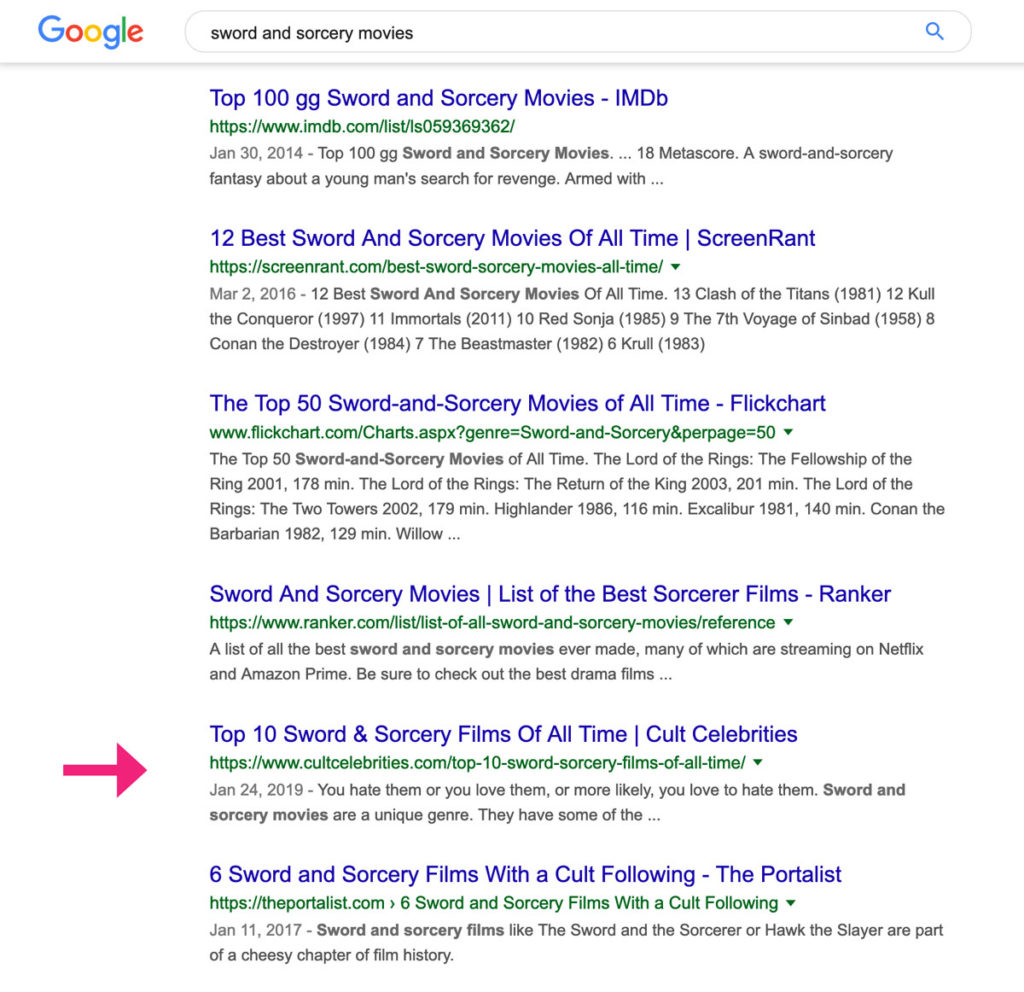
Analyzing the Site’s Success
Now that I’ve revealed the site, you can probably gather a bit more insight about why it was so successful (relatively, of course…it’s not like I’m going to retire off a B-movie site). Here’s why I think Cult Celebrities is doing so well.
- 1) We chose a very tech-backwards niche. There are a lot of competing sites in this niche, many of which have been around for 15 years or more. But that doesn’t mean the competition is that great at SEO. It doesn’t take a lot to stand out. Our only real competitors are the big movie sites like IMDb or Rotten Tomatoes.
- 2) We have gone insane on content creation. Right now we have around 200 published articles and about 50 more in the queue. We’ve also focused on doing everything totally originally, including taking the screenshots ourselves and writing everything from scratch.
- 3) A niche with very little information available. For many of these movies, you can’t find a Wikipedia article or even a plot summary anywhere else on the internet. Some of the actors don’t even have an IMDb profile. It’s open water, and we happen to be the only ones fishing.
- 4) Non-commercial niche. It’s notably difficult to monetize a niche like entertainment. Unless you’ve got millions of pageviews, advertising isn’t going to make you much beer money.
- 5) A focus on Google Images. It’s only just now starting to show benefits, but our exposure on Google Images is absolutely insane. For many of these films, nobody has ever screencapped images from the movie and put them on the internet before. We get around 30-40% of our organic traffic from Images.
What’s Next for Cult Celebrities?
Looking at the traffic metrics over the past eight months, we can’t really give up now. Stu and I work on this site almost every day (in case you couldn’t tell by now, neither of us have much of a life). Our goals at first were modest, but they’re growing.
Here are a few strategies we have in mind.
- Tumblr. Stu has really developed our Tumblr presence, and he is continuing this. Particular movies have a huge following, and we’ve gained almost 400 followers in the past couple of months.
- Reddit. A few Reddit subreddits absolutely dig this sort of content. It helps because it’s non-promotional and visual-heavy. We have our own subreddit now, and are building a little following.
- Guest posts. We’ve found that involving other people in the site vastly improves the community aspect. Other bloggers are more than happy to do a writeup for us, and due to our readership we’re able to materially increase their visitors and even metrics for their podcasts and movie reviews. We want to ramp this up even further.
As far as commercial goals? Not really any commercial intent, except selling cool t-shirts or something. To be realistic, the site technically isn’t worth anything beyond a couple thousand bucks at the moment. We’ve been focused on growing it rather than making anything from it, but that may change in the future once we start getting some more traffic.
Back to links and content and SEO
After my last case study, I got a few folks telling me how important linkbuilding is. How it’s crucial to success, growth rates, anchor text, rel=”noopener”, money sites, web 2.0 properties, blah blah blah.
Here’s the deal.
I know links are important. Especially if you’re in a competitive niche.
But linkbuilding campaigns are not necessary and, regardless of what the legions of sweaty linkbuilders say (typing furiously with Cheetos-dust-covered-fingers) it’s less and less relevant to many ranking situations. With this site, I have zero worry about algorithm changes. The site is doing better every day.
There is no silver solution to SEO. There is no magic bullet. No single way to make your site successful. The only universal truth to SEO? When you build something people love – no matter how few people there are who love that particular thing – your site is going to do well.
Part 3: September 30, 2019
One year ago, on September 30th of 2018, I registered cultcelebrities.com.
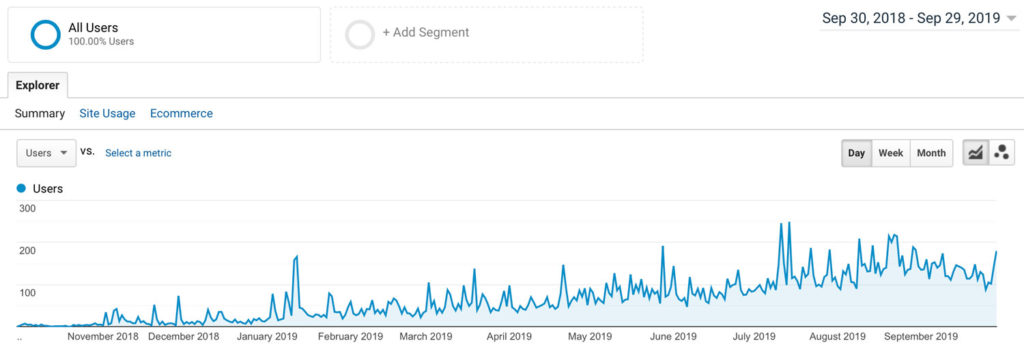
Don’t ask Anya about how many domain names I buy. It’s an embarrassing amount. Maybe 10% of my domains actually end up going anywhere. The goal of Cult Celebrities was to be a fun side project, a simple website with information about cult films and B movies.
I decided to sandbox it and use it as an experiment: could I build a successful site with lots of organic traffic, without building backlinks? Could it be done purely through content creation?
The site ended up doing much better than expected, so I used it for a couple case studies. Five months after I started the site, I published the first part of the case study. At that point, the site was getting around 1,250 unique visitors a month. At the time, I didn’t reveal the site. It wasn’t until I published the second part of the case study at the eight month mark that I revealed it. At the time of my second case study, I still hadn’t intentionally built any backlinks, but traffic had ballooned to 2,500 unique visitors a month (and picked up some incidental backlinks from other folks along the way).
Well, so here we are. One year into my experiment, and we’ve got a site that has sort of blown away my own expectations. In the grand scheme of things it’s still a very small, insignificant site, but the SEO performance has been overwhelmingly solid. And I still haven’t done a traditional linkbuilding campaign, other than linking to it from here on the Discosloth blog and organic interaction on Reddit and Tumblr.
At this point, cultcelebrities.com has over 4,500 visitors per month. The growth rate has been very consistent. We’ve averaged a 24% increase in traffic over the past six months. And that’s a big deal, because we really haven’t changed our modus operandi in any significant way. The only thing that has really changed is that we post regularly on Reddit and Tumblr (those people love this kind of stuff) but organic traffic is still around 80% of our overall traffic.
The number one thing we have done is publish content. Lots of it. Lots of good, original content. We have over 300 published articles so far, along with over 6,200 original images. That’s right – we add a lot of images, and every one of them is something that Stu or I screen captured and edited ourselves. Because of this, we get around a third of our Google search traffic from Image Search.
Engagement is very solid. We average around two minutes and 2-3 pages per visit. Some visitors do skew that number. I’m looking at you, strange fellow from Germany, who spent hours on the site looking at 105 different pages.
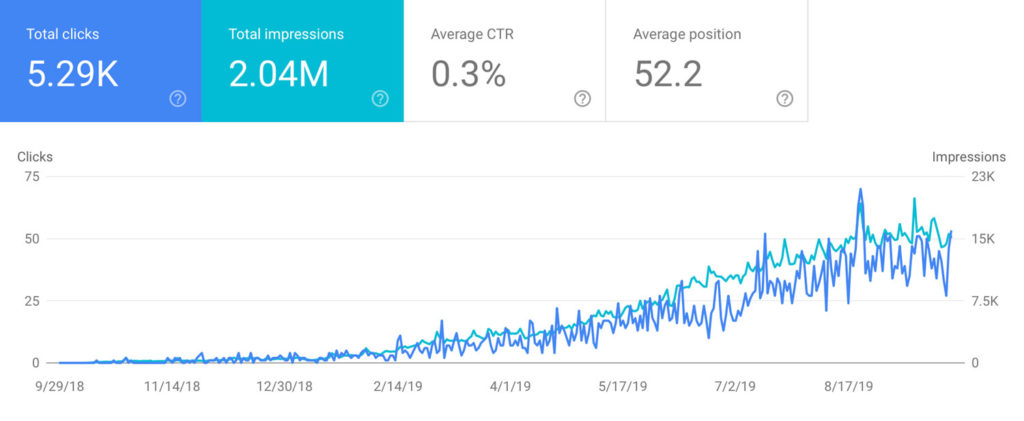
In general, the vast majority of our users are American, Canadian, British, or Australian with a solid minority of Germans and Russians. However, a weird fact I found while digging through our analytics. Chinese folks are ridiculously obsessed with this site. We don’t have many Chinese visitors by volume, but on average they spend 30+ minutes and visit 20+ pages.
Over the past couple months, we’ve improved a few small things about the site. I’ve continued customizing the theme, trimming up the site and making sure it runs nice and clean, and adjusted our automatic image compression so that pages load faster. We did start a pattern of interviewing filmmakers for our blog, and this was both lots of fun and helped increase our traffic as well.
What’s next with Cult Celebrities?
If our historic growth rate stays the same, we’ll pass 100,000 annual visitors by the end of the year. That’s a huge symbolic number for us, because to me that says we’ve created something that people really want. Collectively, people have spent thousands of hours poring over our content, and that makes me feel good.
Stu and I do have some definite plans for monetization, but that’s still a bit of a secret. It’s no rush. We’ve chosen to not place ads on the site, but perhaps one of these days I’ll do a follow up with some info on how we’re going to make some cold hard moolah from our past year of work.
Some takeaways from building & managing the site
I’ve spent hours poring over our analytics dashboards and SEO tools, trying to dissect which techniques worked for us, which ones didn’t work, and finding ways to increase the site’s engagement and performance on a long-term basis.
It’s been incredibly useful from a business perspective, because I’ve learned a few tricks and best practices that I’ve carried over directly to our client’s websites.
1) Originality
The number one most important thing that I have learned in the past year is that originality sets you apart, in Google’s eyes, more than anything else.
You can’t just scrape content and expect to rank. You can’t just pay a copywriter to re-write existing articles with fresh words.
Google is smart. Very smart. It doesn’t matter how many times you spin an old article, if it’s not actually a valuable article, your site won’t provide you with long-term traffic. Perhaps you’ll be able to rank it for a few months, but anything better will be a fluke.
The downside is that it is very time consuming, and if you hire a writer, very expensive. We didn’t just write an article or two a month. We sometimes published 20-30 articles.
2) Google Images
We don’t use stock photos or images we find on Google Images. It just doesn’t work. Every single one of our images has been captured directly from movies and videos, and edited nicely. And that’s why we’re getting around 1,500 visitors a month from Google Images alone. If you search for many of our featured actors and directors in Google Images, chances are you’ll see 5 or 10 of our photos scattered in the first few rows of results.
Stu has also masterminded the art of image metadata. It’s difficult for us to prove this, but I’m confident that his painstaking process of inserting information directly into the image’s metadata, along with the standard SEO best practices of alt tags and image optimization, has catapulted our images to the top of the rankings.
This doesn’t work with every niche (not all niches are really very conducive to original imagery) but when it works, it works.
3) WordPress is a fickle but rewarding beast
I have been using WP since at least 2006, and have had a love/hate relationship with it since then. It’s bloated and inefficient and slow and insecure.
That said, it’s still somehow better than all the other options out there. I’ve tried almost every other CMS alternative out there. Drupal is a disorganized mess of code, and it takes so long to get anything done in it. Joomla is an antiquated piece of garbage from the early days of the internet. Ghost is a WP clone that just isn’t very flexible and scalable for the sort of web publishing we are doing. I don’t mind Statamic, and seriously considered using it, but ended up sticking with WordPress.
Here are some tips on getting the best out of WordPress:
- install it on a fast VPS
- run Wordfence to beef up security
- run an image optimizer and a caching/performance plugin like WP Rocket
- don’t use page builder plugins like Visual Composer or Elementor
- never ever ever let Revolution Slider anywhere near your installation
4) Don’t depend on or publish content on other platforms.
We made the conscious decision to avoid social media for Cult Celebrities. Here’s why:
We want to build our own fanbase. On our own site. And give our fans what they want, when they want.
Sure, we created accounts on basically every platform, and we’ve gotten some good engagement there. Reddit has sent several thousand new readers to the site. Same with Tumblr. Twitter has 216 followers. Pinterest has 941 monthly viewers.
But we just use those platforms to send people to our site.
Out of principle, we’ve actually refused to add social sharing buttons on our site. Why? Facebook tracks users through every single one of those buttons, even if folks aren’t signed into a Facebook account. I don’t want Facebook’s platform to expand their oily reach onto my own platform.
Where the site is now, and where it’s going to go
Although it’s nice to see large numbers in our Analytics account, we’re not after volume. We’re after diehard fans. And that’s what we’re getting, very slowly. We’ve got a handful of folks who signed up to our email newsletter (around 120) with a couple dozen more each month. Based on the admittedly rough Analytics data that we have, around 400 of our monthly readership comes back, time after time, reading our latest daily posts.
That’s the sort of effect we like to see. It makes me glad that hundreds of people out there spend 15 minutes a week reading our newest content.
At this point, Stu and I are beyond happy with where we’ve taken our stupid little hobby site.
But we still want to grow it. There are so many possibilities!
What if we can publish a book curating all of our best reviews, synopses, and interviews? What if it becomes the IMDb of cult films? What if we just make a lot of internet friends? What if even more actors and directors comment on their own posts (that’s started happening…)
Part 4: Addendum
As of early 2021, our site is now a little over two years old. We average 5000-7000 visitors a month these days, and just crossed 100,000 unique visitors (many of our visitors, around 13%, are return visitors who come by on a monthly or weekly basis). Our email list, Instagram, and Facebook have collectively garnered thousands of connections, and we’re able to reach a large amount of folks with just the click of a button.

In early 2020 we saw a hit in traffic right around the same time the world was forced to stay home from work and veg out on couches. Although you’d think a bunch of nerds being locked down would have increased our traffic, I’m assuming their spouses were making them do productive things instead. I don’t know!
We took this time to redesign the site, modernize it, and by early 2021 traffic has started picking up again.
We haven’t made a lot of money from Cult Celebrities so far (we experimented with Google Ads, some affiliate programs, donations, and sponsorships) but our actual largest project ever has been in the works for a while now.
We’ve noticed an incredible amount of interaction within our site. We’ve been contacted by at least a dozen actors and producers of the films we’ve featured on the site, and we’ve decided to leverage these relationships in order to create something bigger.
